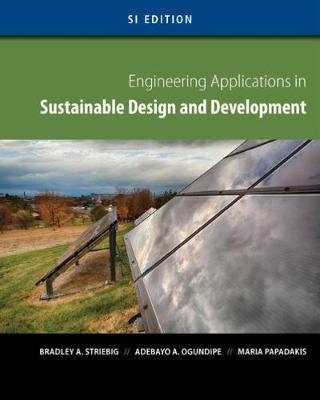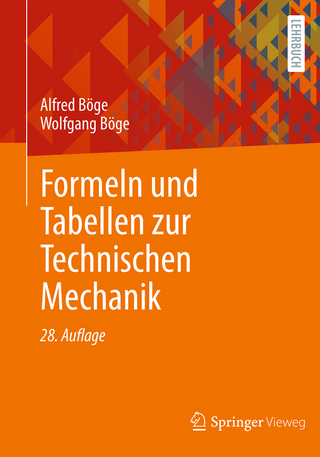
Engineering Applications in Sustainable Design and Development, SI Edition
CL Engineering (Verlag)
978-1-133-62978-8 (ISBN)
International MindTap Engineering for Striebig/Ogundipe/Papadakis' Engineering Applications in Sustainable Design and Development, 1st Edition, helps you learn on your terms.
INSTANT ACCESS IN YOUR POCKET.
Take advantage of the MindTap Mobile App to learn on your terms. Read or listen to textbooks and study with the aid of instructor notifications, flashcards and practice quizzes.
MINDTAP HELPS YOU CREATE YOUR OWN POTENTIAL. GEAR UP FOR ULTIMATE SUCCESS.
Track your scores and stay motivated toward your goals. Whether you have more work to do or are ahead of the curve, you’ll know where you need to focus your efforts. And the MindTap Green Dot will charge your confidence along the way.
MINDTAP HELPS YOU OWN YOUR PROGRESS. MAKE YOUR TEXTBOOK YOURS.
No one knows what works for you better than you. Highlight key text, add notes and create custom flashcards. When it’s time to study, everything you’ve flagged or noted can be gathered into a guide you can organize.
All online text media materials accessible through this access code are available in EMEA, Latin America, Asia, and India only.
Dr. Adebayo A. Ogundipe has held academic positions at Stevens Institute of Technology and the Polytechnic Institute of New York University. He earned his Ph.D from Stevens Institute of Technology. His current areas of specialization and scholarship include life-cycle analysis, industrial ecology and developing methods for assessing sustainability. Dr. Maria Papadakis is a political economist with expertise in energy management and the role of energy in sustainable development. She earned her Ph.D. from Indiana University and has 30 years of experience with technology and manufacturing, energy and sustainable production systems. Dr. Papadakis' research has been published in specialized reports of the National Science Foundation and in such journals as Evaluation and Program Planning, Journal of Technology Transfer, The Scientist and the International Journal of Technology Management. Professor Bradley Striebig received his doctorate in environmental engineering from Pennsylvania State University. He has over 25 years of experience in designing pollution control systems and has worked to improve community resources in Benin, India, Kenya, Malta, Rwanda and throughout the United States. He has served as editor for several journals in the fields of engineering education and engineering for sustainable development. He has led award-winning funded research initiatives, the results of which have contributed to several books, journal articles and peer-reviewed conferences.
1. SUSTAINABILITY, ENGINEERING, AND DESIGN.
Introduction. Human Development Index. Sustainable Development and Social Ethics. Sustainable International Development and Essential Needs for the Poor. Engineering and Developing Communities. Definitions of Sustainability. Population and Consumption. Technical Approaches to Quantifying Sustainability. The Difficulty of Environmental Valuation. Summary.
2. ANALYZING SUSTAINABILTY USING ENGINEERING SCIENCE.
Introduction. Elemental Analysis. Solubility and Henry's Law Constant. The Ideal Gas Law. Chemistry of Natural Systems. Equilibrium Models for Estimating Environmental Impacts. Environmental Fate and Partitioning of Chemicals. Summary.
3. BIOGEOCHEMICAL CYCLES.
Introduction. Biogeochemical Cycles. The Hydrologic Cycle. Water Repositories. Pathways of Water Flow. Precipitation. Watersheds and Runoff. Water Budget. Mass Balance and System Boundaries. Summary.
4. WATER QUALITY IMPACTS.
Introduction. The Water Crisis. Water Quality Parameters. Modeling the Impacts of Water Pollutants. Water Treatment Technologies. Summary.
5. IMPACTS ON AIR QUALITY.
Introduction. Health Effects of Air Pollutants. Estimating Emissions of Air Pollutants. Dispersion of Air Pollutants. Global Impacts of Air Pollutants. Summary.
6. THE CARBON CYCLE AND ENERGY BALANCES.
Introduction. Climate Science History. Carbon Sources and Emissions. The Carbon Cycle, Carbon Flow Pathways and Repositories. Global Energy Balance. Surface Temperature Model. Greenhouse Gases and Effects. Climate Change Projections and Impacts. Carbon Dioxide Mitigation, Capture, and Sequestration. Summary.
7. MODELS FOR ENGINEERING SUSTAINABLE DESIGN.
Introduction. What Do We Mean by Sustainability? The Nature of Natural Resources. Footprint Indicators of Sustainability. Mass Balance and the Footprint Concept. Waste Management and Material Life Cycles. Ecological Design. Sustainable and Green Engineering. Summary.
8. ENERGY CONSERVATION AND DEVELOPMENT.
Introduction. Energy and Society. Energy and the Environment. Direct and Embodied Energy. Opportunities for Energy Sustainability. Appropriate Technology, Scale, and Distributed Energy. Energy Policy. The Water-Energy Nexus. Summary.
9. INDUSTRIAL ECOLOGY.
Introduction. The IPAT Equation. Resource Allocation. Technology, Emissions and Impacts. Risk Assessment and Analysis. Industrial Metabolism. Eco-Industrial Parks. Summary.
10. LIFE CYCLE ANAYLSIS.
Introduction. Life Cycle Thinking. Life Cycle Assessment Framework. Materials Flow Analysis. Embodied Water. Embodied Energy. Impact Assessment. Summary.
11. SUSTAINABILITY AND THE BUILT ENVIRONMENT.
Introduction. Land Use and Land Cover Change. Land Use Planning and its Role in Sustainable Development. Environmentally Sensitive Design. Green Building. Energy Use and Buildings. Summary.
12. CHALLENGES AND OPPORTUNITIES FOR SUSTAINABILTY IN PRACTICE.
Introduction. The Diffusion and Adoption of Innovations. The Economics of Sustainability. The Role of Government. Social Justice and Sustainability in Wealthy Countries. Summary.
GENERAL INDEX.
APPENDIX A: CONVERSION FACTORS.
APPENDIX B: PROPERTIES OF THE EARTH, AIR, AND WATER.
APPENDIX C: SUSTAINABILTY INDICATORS.
APPENDIX D: CARBON SOURCES AND EQUIVALENCE.
APPENDIX E: WATER FOOTPRINTS OF PRODUCTS.
APPENDIX F: RISK ASSESSMENT.
APPENDIX G: WATER CONSERVATION.
REFERENCES.
GLOSSARY.
LIST OF TABLES.
LIST OF FIGURES.
| Sprache | englisch |
|---|---|
| Maße | 205 x 255 mm |
| Gewicht | 1225 g |
| Themenwelt | Technik ► Bauwesen |
| ISBN-10 | 1-133-62978-4 / 1133629784 |
| ISBN-13 | 978-1-133-62978-8 / 9781133629788 |
| Zustand | Neuware |
| Haben Sie eine Frage zum Produkt? |
aus dem Bereich


